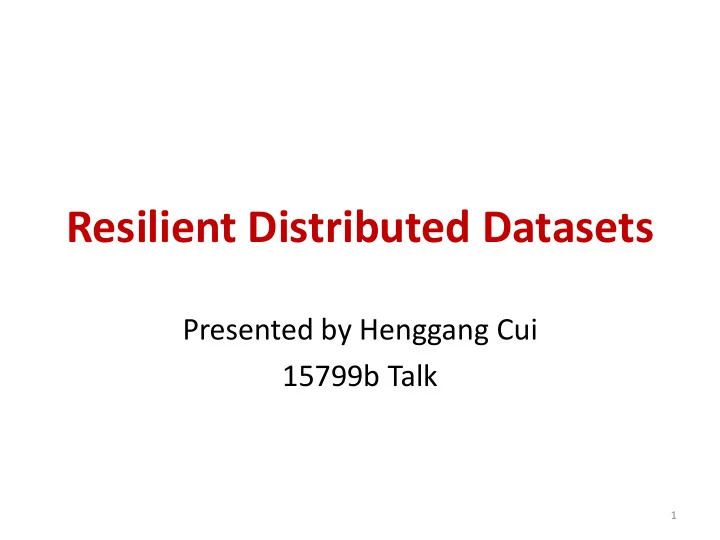

Resilient Distributed Datasets Presented by Henggang Cui 15799b Talk 1
Why not MapReduce • Provide fault-tolerance, but: • Hard to reuse intermediate results across multiple computations – stable storage for sharing data across jobs • Hard to support interactive ad-hoc queries 2
Why not Other In-Memory Storage • Examples: Piccolo – Apply fine-grained updates to shared states • Efficient, but: • Hard to provide fault-tolerance – need replication or checkpointing 3
Resilient Distributed Datasets (RDDs) • Restricted form of distributed shared memory – read-only, partitioned collection of records – c an only be built through coarse‐grained deterministic transformations • data in stable storage • transformations from other RDDs. • Express computation by – defining RDDs 4
Fault Recovery • Efficient fault recovery using lineage – log one operation to apply to many elements (lineage) – recompute lost partitions on failure 5
Example lines = spark.textFile("hdfs://...") errors = lines.filter(_.startsWith("ERROR")) hdfs_errors = errors.filter (_.contains(“HDFS")) 6
Advantages of the RDD Model • Efficient fault recovery – fine-grained and low-overhead using lineage • Immutable nature can mitigate stragglers – backup tasks to mitigate stragglers • Graceful degradation when RAM is not enough 7
Spark • Implementation of the RDD abstraction – Scala interface • Two components – Driver – Workers 8
Spark Runtime • Driver – defines and invokes actions on RDDs – tracks the RDDs’ lineage • Workers – store RDD partitions – perform RDD transformations 9
Supported RDD Operations • Transformations – map (f: T->U) – filter (f: T->Bool) – join() – ... (and lots of others) • Actions – count() – save() – ... (and lots of others) 10
Representing RDDs • A graph-based representation for RDDs • Pieces of information for each RDD – a set of partitions – a set of dependencies on parent RDDs – a function for computing it from its parents – metadata about its partitioning scheme and data placement 11
RDD Dependencies • Narrow dependencies – each partition of the parent RDD is used by at most one partition of the child RDD • Wide dependencies – multiple child partitions may depend on it 12
RDD Dependencies 13
RDD Dependencies • Narrow dependencies – allow for pipelined execution on one cluster node – easy fault recovery • Wide dependencies – require data from all parent partitions to be available and to be shuffled across the nodes – a single failed node might cause a complete re- execution. 14
Job Scheduling • To execute an action on an RDD – scheduler decide the stages from the RDD’s lineage graph – each stage contains as many pipelined transformations with narrow dependencies as possible 15
Job Scheduling 16
Memory Management • Three options for persistent RDDs – in-memory storage as deserialized Java objects – in-memory storage as serialized data – on-disk storage • LRU eviction policy at the level of RDDs – when there’s not enough memory, evict a partition from the least recently accessed RDD 17
Checkpointing • Checkpoint RDDs to prevent long lineage chains during fault recovery • Simpler to checkpoint than shared memory – Read-only nature of RDDs 18
Discussions 19
Checkpointing or Versioning? • Frequent checkpointing, or Keep all versions of ranks? 20
Recommend
More recommend